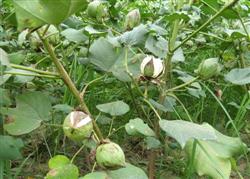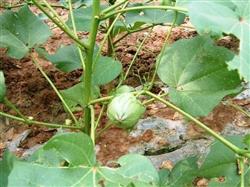Cotton planting technology: what is the use of potassium spraying cotton in August?

What is the use of spraying potassium on cotton in August? Please introduce that in August, with the deterioration of soil permeability and the decrease of soil temperature after ridge closure, the soil potassium supply capacity is weakening day by day. If potassium fertilizer can not be replenished in time, it will show obvious potassium deficiency. The potassium deficiency of cotton starts from the lower old leaves. Generally, the veins remain green, while the mesophyll gradually fades. Because potassium is highly active in plants, it is mostly concentrated in the young and metabolic parts. When cotton plants are deficient in potassium, potassium first transfers from the old leaves to the young tissues. For example, the potassium-deficient cotton field suffered sudden low-temperature rainfall in the first and middle of September, and the supply of available potassium in the soil was almost interrupted. when the basic potassium nutrition of cotton leaves could not be maintained, the cotton plants would suddenly show physiological failure, and the cotton leaves would quickly turn yellow or red within two or three days. then dry up and fall off, the stem withered and the cotton plant died, which is also called red leaf stem blight, so it is too late to take any measures. Therefore, the first and middle of August is the key period of potassium supplement for cotton, and foliar potassium spraying is the most economical and effective potassium supplement method, and the available potassium must be applied before the cotton plant is seriously deficient in potassium. If the cotton plant is in a state of serious potassium deficiency in August and can not be replenished timely and effectively, it will result in the decrease of upper boll setting or no boll, delayed boll initiation, poor boll opening, lower lint percentage, leaf shedding, and even the death of the whole plant. There have been many painful lessons in previous years. Which variety of potash fertilizer is best to be foliar sprayed? There are four principles for fertilizer selection: (1) the principle of high potassium; (2) the principle of high solubility; (3) the principle of easy absorption and utilization and safety and harmlessness; and (4) the principle of low input. According to the above four principles, potassium sulfate is the best foliar fertilizer spraying variety: (1) High quality potassium sulfate contains more than 50% potassium oxide, which is much higher than any other compound potassium fertilizer variety, if one jin of potassium sulfate is sprayed per mu, it can provide cotton with the potassium needed to produce 10 jin of seed cotton; (2) it is soluble in water and can dissolve 13 grams of potassium sulfate per 100 grams of water at 30 degrees Celsius, which is easy to spray under any conditions. (3) it is easy to be absorbed and utilized by cotton, and it is safe and reliable within a certain spraying concentration; (4) according to the unit effective ingredient, the price is lower than any other potash fertilizer varieties. Fertilizer spraying method: 2% concentration is appropriate, 60 jin per mu is sprayed, only the upper half of the cotton plant is sprayed, wet both sides of the leaves are sprayed, and the spraying time should be avoided from the period of maximum evaporation after 10:00 to 3 p.m., the finer the fog point is, the safer the cotton is. Pay attention to the cotton plants on the edge of the ground not to spray again, spraying once every seven or eight days, three times in a row. If mixed with pesticides, it is necessary to reduce the amount of fertilizer and increase the frequency of fertilizer spraying. According to the practical experience of cotton farmers, the effect of spraying powdered potassium sulfate produced in Russia is the best, with a potassium oxide content of up to 52%, fast dissolution and almost no precipitation. However, the large particles of potassium sulfate which are difficult to dissolve are not suitable for foliar fertilizer spraying. The second and third grade potassium sulfate has low potassium content and many fillers, so it is not suitable for fertilizer spraying. Potassium chloride contains up to 60% potassium oxide, dissolving is good, but cotton leaves are more sensitive to chloride ions, such as foliar fertilizer spraying, it is appropriate to use 1% concentration to ensure safety. Potassium dihydrogen phosphate is an outdated variety of cotton foliar fertilizer, with low potassium content and high phosphorus content, low spraying concentration and high input, so it is suitable for cotton fields with little potassium deficiency from 1970s to 1980s. In the cotton field with serious potassium deficiency, spraying potassium dihydrogen phosphate is far from satisfying the cotton plant's thirst for potassium. Phosphorus can no longer be sprayed in premature senile cotton fields, precocious cotton fields, cotton fields with vigorous reproductive growth but weak vegetative growth. Potassium dihydrogen phosphate is suitable for cotton fields with excessive vegetative growth and late ripening trend. Potassium nitrate is a gunpowder and industrial raw material with high price and high investment. it is suitable to be used in cotton fields which lack both potassium and nitrogen in the later stage. "potassium sulfate compound fertilizer" belongs to compound fertilizer, not potash fertilizer, which has low potassium content and can not be sprayed as potash fertilizer. In general, spraying high-quality potassium sulfate is the most simple and economical in cotton fields. Practice has proved that it can achieve a better potassium supplement effect. Click to get more cotton planting technology click to get more food crop planting technology
- Prev

Cotton planting techniques: how to manage cotton in August?
How to manage cotton in August? Please introduce the method. August is the period from cotton blossom to boll opening. It is the key period of protecting summer peach and competing for autumn peach. The main task of cotton field management is to improve the ventilation and light transmission conditions of cotton field, maintain root activity, prevent greedy green late ripening, and prevent premature senescence. 1. The growth of topping fertilizer is normal.
- Next

Cotton planting technology: What is the main management of cotton in July?
What does cotton mainly manage in July? Please introduce the following main cotton management points in July: (1) ditching and cultivating soil. It is beneficial to watering and drainage, which can prevent drought and waterlogging. It is also beneficial to ventilation in the lower part of cotton field, reduce humidity, increase temperature difference between day and night, and is conducive to improvement of cotton field microclimate.
Related
- The first cup of black tea in spring, the flavor and history of tea gardens in Kenya, Africa
- The computer can not only choose potatoes, but also grow tea rice. AI will grow winter oolong tea champion.
- It is not only the inflated tea bitten by insects, but also engraved with the four seasons tea in Beipu.
- The Oriental Beauty Tea Festival in Zhuxian County takes the stage at the weekend to experience the plus-size feast of oil tea.
- & quot; Oriental Beauty Tea & Exploration of Emei in Hsinchu, the hometown of quot;
- The new variety of strawberry "Tainong 1" dessert is the first choice with mellow aroma. Crimson gorgeous
- History of Tea in Taiwan: from Wild Inner Mountain to Export Tea Garden
- Two types of Taiwan Oriental Beauty Black Tea won the British three-Star Award for Childhood Tea Xiang Zhang Jiaqi changed from pilot to champion tea maker.
- Banana species and varieties: the planting history of Taiwan Xianren banana and dwarf banana is long, is banana disease resistant?
- Coffee planting Technology: Qianjie Coffee from Seedling to harvesting

